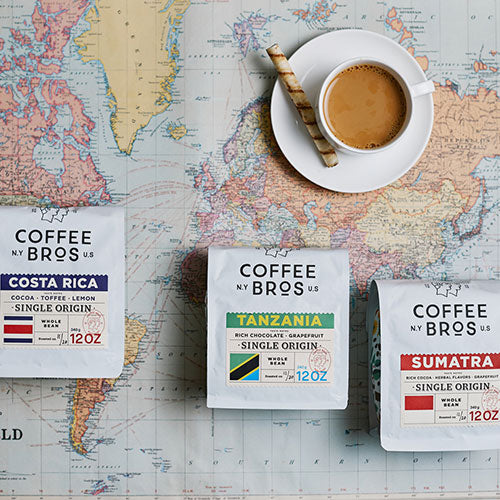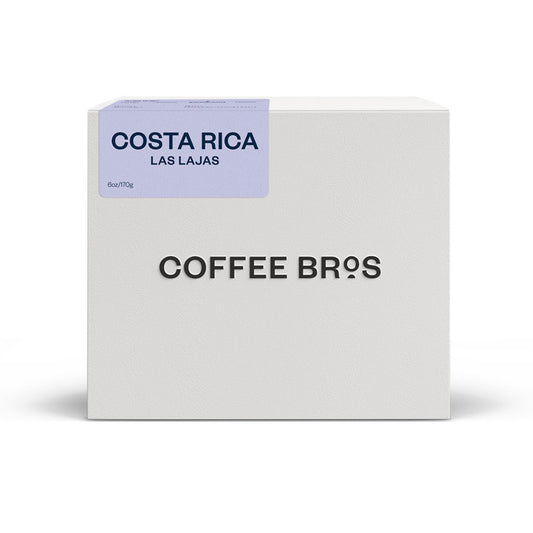Collection: Costa Rica
-
Best Seller
Costa Rican | Las Lajas | Natural
An exceptionally well-balanced coffee with winey fruit and chocolate notes
An exceptionally well-balanced coffee with wine...
Regular price From $13.40Regular priceUnit price / per -
Holiday Blend Coffee | Costa Rica, Colombia | Natural
A seasonal holiday blend from all-star producers Las Lajas and La Esperanza
A seasonal holiday blend from all-star producer...
Regular price From $13.40Regular priceUnit price / per
Looking for something extraordinary? We've got a selection of unique coffees from different roast types to origins. Use the selection below to find your match!
Collections
-

All Coffee
Experience the best specialty coffee with our selection of Signature Series, Single-origin,...
-

Single Origin
All of our single-origin coffees in this collection are 86+ point coffees...
-

Signature Blends
Our Signature Blend coffees showcase unique flavor profiles that shine across any...
All About Coffee from Costa Rica
What is the history of coffee in Costa Rica?
Coffee was first introduced to Costa Rica in the late 1700s and became a major export in the 1820s with great economic significance. In 1846, the completion of a main road to Puntarenas allowed farmers to transport their coffee more easily to market using oxcarts. In 1933, the national coffee association, Icafe, was established to support the agricultural and commercial development of the coffee industry in Costa Rica. It is funded by a 1.5% export tax on all coffee exports, with a budget of $7 million for research and oversight. The organization ensures that farmers receive 80% of the FOB price. Despite contributing less than 1% of the world's coffee production, Costa Rica has a strong reputation for producing high-quality, mild coffee. This is due to the diverse growing regions and variety selection by producers. Some of the most famous regions are Tarrazú, known for its crisp acidity, West Valley with many Cup of Excellence winners, Tres Ríos with a mild profile, and Central Valley with well-defined wet and dry seasons. In recent years, producers have been focusing on variety selection to stand out in the market, including SL-28, Gesha, Villa Sarchi, and Venesia.
How is coffee typically sold in Costa Rica?
Micromills, which are privately owned wet and dry milling facilities, have also aided Costa Rican coffee producers in standing out. These facilities are built by individual producers or small groups to control the processing and separation of their coffee lots. By having access to equipment such as depulpers and demucilaging machines, producers can process their coffee in various ways without having to rely on external mills, reducing operating costs and allowing for higher coffee prices.
What coffee processing methods do they use in Costa Rica?
Costa Rican coffee has gained recognition in the past decade, thanks to the popularity of processing innovations in the country. Among these are the honey process, a hybrid of washed and pulped-natural process that originated in Costa Rica, and the natural process, which is growing in popularity due to its high-price profile and the challenges of producing washed coffees because of water restrictions. Micromills, private processing facilities, are playing a significant role in these innovations. In Costa Rica, coffee is measured by volume, with 20 metal boxes (cajuelas) equaling roughly one fanega (100 pounds). The average yearly production of coffee in the country is 1.8-2.2 million fanegas.
What are the common coffee varietals in Costa Rica?
The most widely grown coffee varieties in Kenya are SL-28, SL-34, French Mission Bourbon, Ruiru 11, Batian, and K7.
What is the SL-28 and SL-34 coffee varietal?
SL-28 and SL-34 varietals which tend to have unmatched sweetness with a dynamic flavor profile. SL-28 is among the most well-known and well-regarded varieties of Africa. It has consequently spread from Kenya, where it was originally planted in the 1930s, to other parts of Africa and now to Latin America.
Where are the most common coffee growing regions in Costa Rica?
The most common coffee-growing regions in Costa Rica include, Central Valley, West Valley, Guanacaste, Tres Ríos, Turrialba, Orosi, Brunca, and Tarrazú.
When does the coffee harvest begin in Costa Rica?
Costa Rica's harvest begins from December to April, with typical arrivals occurring from May to July.
- Choosing a selection results in a full page refresh.






